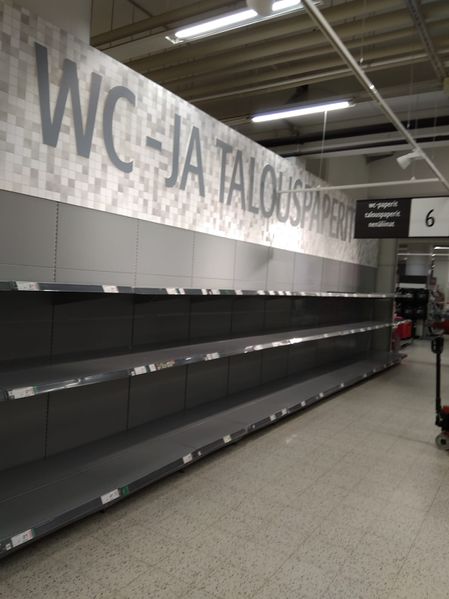File:K-Citymarket 13 March 2020.jpg
Jump to navigation
Jump to search


Size of this preview: 449 × 599 pixels. Other resolutions: 180 × 240 pixels | 1,511 × 2,015 pixels.
Original file (1,511 × 2,015 pixels, file size: 186 KB, MIME type: image/jpeg)
Summary
Empty shelves for toilet paper in K-Citymarket in Ruoholahti in Helsinki, Finland on March 13, 2020
- Source
- Own photo
- Analysis
- The Great Toilet Paper Scare of 1973 - Zachary Crockett, Priceonomics, July 9, 2014
- What Everyone’s Getting Wrong About the Toilet Paper Shortage - Will Oremus, Marker, April 2, 2020 (mirror)
- Talk to anyone in the industry, and they’ll tell you the toilet paper made for the commercial market is a fundamentally different product from the toilet paper you buy in the store. It comes in huge rolls, too big to fit on most home dispensers. The paper itself is thinner and more utilitarian. It comes individually wrapped and is shipped on huge pallets, rather than in brightly branded packs of six or 12.
- “Not only is it not the same product, but it often doesn’t come from the same mills,” added Jim Luke, a professor of economics at Lansing Community College, who once worked as head of planning for a wholesale paper distributor. “So for instance, Procter & Gamble [which owns Charmin] is huge in the retail consumer market. But it doesn’t play in the institutional market at all.”
- Georgia-Pacific, which sells to both markets, told me its commercial products also use more recycled fiber, while the retail sheets for its consumer brands Angel Soft and Quilted Northern are typically 100% virgin fiber. Eric Abercrombie, a spokesman for the company, said it has seen demand rise on the retail side, while it expects a decline in the “away-from-home activity” that drives its business-to-business sales.
- In theory, some of the mills that make commercial toilet paper could try to redirect some of that supply to the consumer market. People desperate for toilet paper probably wouldn’t turn up their noses at it. But the industry can’t just flip a switch. Shifting to retail channels would require new relationships and contracts between suppliers, distributors, and stores; different formats for packaging and shipping; new trucking routes — all for a bulky product with lean profit margins.
- While toilet paper is an extreme case, similar dynamics are likely to temporarily disrupt supplies of other goods, too — even if no one’s hoarding or panic-buying. The CEO of a fruit and vegetable supplier told NPR’s Weekend Edition that schools and restaurants are canceling their banana orders, while grocery stores are selling out and want more. The problem is that the bananas he sells to schools and restaurants are “petite” and sold loose in boxes of 150, whereas grocery store bananas are larger and sold in bunches. Beer companies face a similar challenge converting commercial keg sales to retail cans and bottles.
File history
Click on a date/time to view the file as it appeared at that time.
| Date/Time | Thumbnail | Dimensions | User | Comment | |
|---|---|---|---|---|---|
| current | 18:58, 14 March 2020 |  | 1,511 × 2,015 (186 KB) | Petri Krohn (talk | contribs) | Empty shelves for toilet paper in K-Citymarket in Ruoholahti in Helsinki, Finland on March 13, 2020 ;Source * Own photo |
You cannot overwrite this file.
File usage
The following page uses this file: